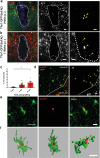Microglia contribute to the propagation of Aβ into unaffected brain tissue
- PMID: 34811521
- PMCID: PMC8737330
- DOI: 10.1038/s41593-021-00951-0
Microglia contribute to the propagation of Aβ into unaffected brain tissue
Abstract
Microglia appear activated in the vicinity of amyloid beta (Aβ) plaques, but whether microglia contribute to Aβ propagation into unaffected brain regions remains unknown. Using transplantation of wild-type (WT) neurons, we show that Aβ enters WT grafts, and that this is accompanied by microglia infiltration. Manipulation of microglia function reduced Aβ deposition within grafts. Furthermore, in vivo imaging identified microglia as carriers of Aβ pathology in previously unaffected tissue. Our data thus argue for a hitherto unexplored mechanism of Aβ propagation.
© 2021. The Author(s).
Conflict of interest statement
The authors declare no competing interests.
Figures












Comment in
-
Two-faced behavior of microglia in Alzheimer's disease.Nat Neurosci. 2022 Jan;25(1):3-4. doi: 10.1038/s41593-021-00963-w. Nat Neurosci. 2022. PMID: 34815557 No abstract available.
-
Microglia-Mediated Aβ Propagation in Alzheimer's Disease.Neurosci Bull. 2022 Oct;38(10):1274-1276. doi: 10.1007/s12264-022-00907-9. Epub 2022 Jun 21. Neurosci Bull. 2022. PMID: 35729454 Free PMC article. No abstract available.
References
-
- Sosna J, et al. Early long-term administration of the CSF1R inhibitor PLX3397 ablates microglia and reduces accumulation of intraneuronal amyloid, neuritic plaque deposition and pre-fibrillar oligomers in 5XFAD mouse model of Alzheimer’s disease. Mol. Neurodegener. 2018;13:11. doi: 10.1186/s13024-018-0244-x. - DOI - PMC - PubMed
Publication types
MeSH terms
Substances
LinkOut - more resources
Full Text Sources
Molecular Biology Databases

